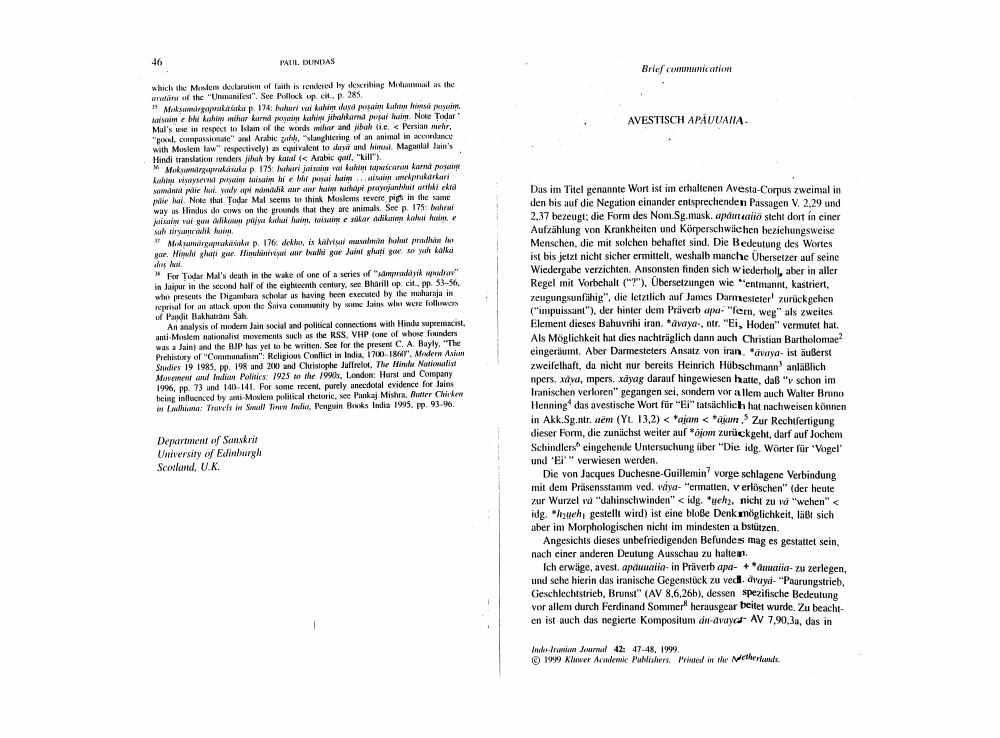________________ 46 PAUL DUNDAS Brief communication AVESTISCH APAUUANIA which the Moslem declaration of faith is rendered by describing Mohammad as the autara of the "Unmanifest". See Pollock op. cit., p. 285. 35 Moksamargaprakasaka p. 174: buhuri vai kahim daya posaim kuhim himsa posaim, taisaim e bhi kahim mihar karna posaim kahim jibahkarna posui haim. Note Todar' Mal's use in respect to Islam of the words mihar and jibah (i.e. < Persian mehr, "good, compassionate" and Arabic zubh, "slaughtering of an animal in accordance with Moslem law" respectively) as equivalent to day, and himsai. Maganlal Jain's Hindi translation renders jibah by katal (< Arabic qail, "kill"). 36 Moksamargaprakusuka p. 175: bahari jaisaim vai kahim tapascaran karna posaim kahim visaysevna posaim taisaim hi e bhi posai haim ...aisaim anekprukarkari samanta paie hui. yady api namadik aur aur haim Ruthapi prayojanbhit arthki ekta paie hai. Note that Todar Mal seems to think Moslems revere pigs in the same way as Hindus do cows on the grounds that they are animals. See p. 175: bahrui jaisaim vai gan adikaum pujya kahai haim, taisaim e sukar adikaum kahai haim, e sub tiryamcadik haim. 37 Moksumargaprakasaka p. 176: dekho, is kalvisai musalman bahut pradhan ho gae. Himdi ghati gae. Himdunivisai aur badhi gae Juini ghati gae, so yah kalka dos lai. 38 For Todar Mal's death in the wake of one of a series of "sampradayik upadrav" in Jaipur in the second half of the eighteenth century, see Bharill op. cit., pp. 53-56, who presents the Digambara scholar as having been executed by the maharaja in reprisal for an attack upon the Saiva community by some Jains who were followers of Pandit Bakhatram Sah. An analysis of modern Jain social and political connections with Hindu supremacist, anti-Moslem nationalist movements such as the RSS, VHP (one of whose founders was a Jain) and the BJP has yet to be written. See for the present C. A. Bayly, "The Prehistory of "Communalism": Religious Conflict in India, 1700-1860", Modern Asian Studies 19 1985, pp. 198 and 200 and Christophe Jaffrelot, The Hindu Nationalist Movement and Indian Politics: 1925 to the 1990s, London: Hurst and Company 1996, pp. 73 and 140-141. For some recent, purely anecdotal evidence for Jains being influenced by anti-Moslem political rhetoric, see Pankaj Mishra, Butter Chicken in Ludhiana: Travels in Small Town India, Penguin Books India 1995, pp. 93-96. Das im Titel genannte Wort ist im erhaltenen Avesta-Corpus zweimal in den bis auf die Negation einander entsprechenden Passagen V. 2,29 und 2.37 bezeugt: die Form des Nom.Sg.mask. apatu aiio steht dort in einer Aufzahlung von Krankheiten und Korperschwachen beziehungsweise Menschen, die mit solchen behaftet sind. Die Bedeutung des Wortes ist bis jetzt nicht sicher ermittelt, weshalb manche Ubersetzer auf seine Wiedergabe verzichten. Ansonsten finden sich wiederholt, aber in aller Regel mit Vorbehalt ("?"), Ubersetzungen wie "entmannt, kastriert, zeugungsunfahig", die letztlich auf James Darmesteter' zuruckgehen ("impuissant"), der hinter dem Praverb apa- "fern, weg" als zweites Element dieses Bahuvrihi iran. *avaya-, ntr. "Ei, Hoden" vermutet hat. Als Moglichkeit hat dies nachtraglich dann auch Christian Bartholomae? eingeraumt. Aber Darmesteters Ansatz von iran. *avaya- ist ausserst zweifelhaft, da nicht nur bereits Heinrich Hubschmann' anlasslich npers. xaya, mpers. xayag darauf hingewiesen hatte, dass "y schon im Iranischen verloren" gegangen sei, sondern vor allem auch Walter Bruno Henningt das avestische Wort fur "Ei" tatsachlich hat nachweisen konnen in Akk.Sg.ntr. aem (Yt. 13,2) < *ajam < *ajam. Zur Rechtfertigung dieser Form, die zunachst weiter auf *ajom zuruckgeht, darf auf Jochem Schindlers eingehende Untersuchung uber "Die idg. Worter fur 'Vogel und 'Ei?" verwiesen werden. Die von Jacques Duchesne-Guillemin' vorge schlagene Verbindung mit dem Prasensstamm ved. vaya- "ermatten, verloschen" (der heute zur Wurzel va "dahinschwinden" < idg. *ueh2, nicht zu va "wehen" < idg. *houeh, gestellt wird) ist eine blosse Denk moglichkeit, lasst sich aber im Morphologischen nicht im mindesten a bstutzen. Angesichts dieses unbefriedigenden Befundes mag es gestattet sein, nach einer anderen Deutung Ausschau zu halten. Ich erwage, avest. apauuaiia- in Praverb apa- + *auuaiia- zu zerlegen. und sehe hierin das iranische Gegenstuck zu ved. avaya- "Paarungstrieb, Geschlechtstrieb, Brunst" (AV 8,6,26b), dessen spezifische Bedeutung vor allem durch Ferdinand Sommer herausgear beitet wurde. Zu beachten ist auch das negierte Kompositum an-avaydo AV 7,90,3a, das in Department of Sanskrit University of Edinburgh Scotland, U.K. Indo-Iranian Journal 42: 47-48, 1999. (c) 1999 Kluwer Academic Publishers. Printed in the Netherlands.




